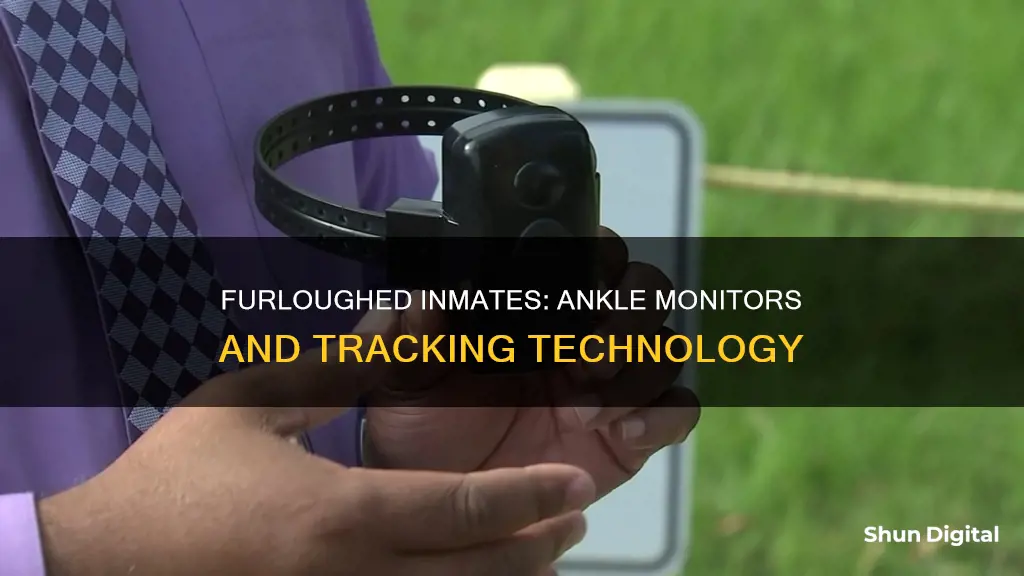
During the COVID-19 pandemic, as jails became hotspots for the virus, many judges ordered the release of inmates on ankle monitors. Ankle monitors are electronic devices fastened to a person's ankle, allowing law enforcement to track their whereabouts. While these devices are meant to protect society and advance rehabilitation, critics argue that they fail to achieve these goals and often lead to more incarcerations due to malfunctions, false alarms, and minor technical violations. The use of ankle monitors has sparked debates about their effectiveness and potential negative impact on individuals trying to rebuild their lives after prison.
| Characteristics | Values |
|---|---|
| Use of ankle monitors | Ankle monitors are used to track the whereabouts of furloughed inmates. |
| Who uses them | Ankle monitors are used by law enforcement authorities and private companies contracted by law enforcement. |
| Purpose | Ankle monitors are used to protect society, advance rehabilitation, and reduce prison populations. |
| Effectiveness | There is no evidence that ankle monitors are rehabilitative, and they may lead to more people being incarcerated due to malfunctions, false alarms, and minor technical violations. |
| Alternatives | Alternatives to ankle monitors include smartphone technology, which can provide a less stigmatizing and more effective way to monitor individuals. |
| Cost | The cost of ankle monitors is often passed on to the individuals wearing them, ranging from $2 to $20 per day, excluding activation fees. |
What You'll Learn

Ankle monitors are a form of digital jail
The High Costs of Ankle Monitors
The cost of ankle monitors is often passed on to the wearer, with fees ranging from $2 to $20 a day, and additional activation and installation fees. These costs can be exorbitant, sometimes exceeding monthly rent, and failure to pay can result in a return to jail. In Kentucky, for example, individuals can be sent back to prison if they are three days late on payments.
Impact on Employment and Daily Life
Ankle monitors can significantly impact employment prospects and daily life. The bulky devices are hard to conceal, drawing unwanted attention and stigmatization. Finding employment becomes challenging as potential employers may view the monitor as a red flag. Additionally, charging the device daily can be inconvenient, requiring individuals to return home or find a power outlet in public.
Strict Rules and Surveillance
The rules associated with ankle monitors can be extremely restrictive. Wearers may be confined to their homes, with specific curfews, and face limitations on their movements. Any violation of these rules, such as leaving home during a curfew or entering prohibited areas, can result in severe consequences, including a return to jail. The constant surveillance and tracking of movements can also take a mental toll, causing individuals to feel trapped and incarcerated even before a trial.
Technical Glitches and False Violations
Technical glitches and false violations are common issues with ankle monitors. Losing signal or experiencing a dead battery can easily occur, and individuals may find themselves in violation of their release conditions due to these technical failures. This can lead to unnecessary law enforcement involvement and potential incarceration.
Limited Effectiveness and Rehabilitation
There is limited evidence that ankle monitors effectively prevent reoffending or improve public safety. While they may provide an alternative to incarceration, they do not address the root causes of criminal behavior or provide genuine rehabilitation. Instead, they can extend sentences and curtail freedoms, functioning as an additional punishment.
In conclusion, while ankle monitors are promoted as a more humane option, they often create a form of digital jail, imposing financial burdens, restricting movement, and causing constant surveillance that can negatively impact the lives of those trying to reintegrate into society.
Minimize Power Consumption with Multiple Monitors: CPU Efficiency Tips
You may want to see also

Ankle monitors can be used as an alternative to bail
Ankle monitors have been used as an alternative to bail for those awaiting trial, particularly during the COVID-19 pandemic when jails became coronavirus hotspots. They can be used as a condition of bail or parole, or for those deemed low-risk, non-violent offenders.
Ankle monitors are often used to ensure individuals comply with the terms of their release, such as sticking to a specific area, avoiding certain people, adhering to a curfew, or refraining from drinking alcohol. They can also be used to ensure a required distance is maintained, such as in cases of domestic violence.
The use of ankle monitors allows individuals to remain out of custody while awaiting trial, maintain their jobs and support their families, and reduce incarceration costs. They also provide an additional layer of security and compliance, ensuring individuals appear for their day in court and comply with court orders.
However, ankle monitors can also present challenges and concerns. They can be uncomfortable and cause skin irritation. Individuals are often subject to strict rules and regulations, and any violation can result in additional penalties or imprisonment. There are also privacy concerns and the potential impact on employment due to the stigma associated with wearing a visible monitor.
Despite these challenges, ankle monitors have been shown to have positive outcomes, with individuals successfully navigating their legal challenges and achieving better outcomes in their cases with the support of dedicated bail bond companies.
Disabling Ankle Monitors: A Step-by-Step Guide
You may want to see also

Ankle monitors can be used as an alternative to incarceration
Ankle monitors are increasingly being viewed as a more humane alternative to incarceration. They are used to track individuals who are under the supervision of the criminal justice system, allowing them to serve their sentences while remaining in the community. Typically, ankle monitors are used for individuals on probation or parole, or those awaiting trial. They can also be used for individuals convicted of a crime but are considered low-risk and not a danger to the community.
Ankle monitors have several advantages over traditional imprisonment. They are less expensive than keeping an individual in jail or prison, and they allow individuals to maintain their jobs and support their families. This can make it easier for them to reintegrate into society once their sentences are completed. Additionally, they can be used to monitor individuals who are at high risk of reoffending, providing an extra layer of supervision and a chance for rehabilitation within the community.
However, there are also disadvantages and concerns associated with the use of ankle monitors. For one, they can be uncomfortable to wear and may cause skin irritation. More significantly, critics argue that ankle monitors deprive people of fundamental rights, violate privacy, jeopardize employment, and undermine family and social relationships. The very nature of the device limits the wearer's movement and can lead to reincarceration for minor technical violations. The cost of the device is often passed on to the wearer, adding a financial burden that can be challenging to bear, especially during times of unemployment.
While ankle monitors can be a viable alternative to incarceration in certain situations, it is important to use them with discretion and consider the offender's risk of recidivism and the nature of the crime.
Removing Glass Fragments from Your Monitor Safely
You may want to see also

Ankle monitors can be stigmatising
Ankle monitors, also known as ankle bracelets, ankle shackles, or tethers, have been used as an alternative to incarceration since the 1980s. They are often used to track the location of people on parole, probation, pretrial supervision, or facing immigration proceedings. While these monitors are meant to reduce prison populations and allow people to stay in their communities, they have also been criticised as a form of "e-carceration" that perpetuates stigma, social isolation, and stress for the wearers.
Research suggests that the design of ankle monitors has not changed significantly in 30 years, indicating that the stigma and difficulty of concealment may be intentional. Lauren Kilgour, a doctoral student in information science at Cornell University, argues that the bulkiness and conspicuousness of ankle monitors are in stark contrast to the sleek and inconspicuous design of commercial wearable technology like Apple Watches or Fitbits. Kilgour further links ankle monitors to a historical tradition of shaming and marking individuals as criminals, invoking a "profoundly prejudiced history of taking people and marking them in ways that are meant to effectively act as a type of punishment."
The stigma associated with ankle monitors can have significant social and psychological impacts on the wearers. People on ankle monitors are often presumed to be dangerous criminals, regardless of the specifics of their case. This presumption can lead to social isolation and the compromising of privacy, making it difficult for them to form strong social bonds within their communities. It may also impact their employment prospects and exacerbate mental health issues such as depression and anxiety.
In addition to the stigma, ankle monitors can also be physically uncomfortable and restrictive. One wearer described their experience, saying, "I worry my friends will spot it and leave me. I push it up into my jeans, hoping they won't see. But the higher up I push it, the more it starts to hurt: most days, my feet go numb. I try wearing bell-bottoms." The physical discomfort and constant reminder of being monitored can take a toll on the mental health and well-being of the wearers.
Best Places to Buy Ultrawide Monitors: A Comprehensive Guide
You may want to see also

Ankle monitors can be monitored by private companies
Ankle monitors are often used as a form of surveillance for people on bail, probation, or parole. They can also be used for those awaiting trial or facing immigration proceedings. These devices track a person's whereabouts and can send specific data and coordinates to a monitoring company.
During the COVID-19 pandemic, as jails became hotspots for outbreaks, many inmates were released early and placed on ankle monitors. This led to a significant increase in the use of electronic monitoring across the United States. While ankle monitors are often seen as a preferable alternative to incarceration, there are concerns about their effectiveness and impact on civil liberties.
The use of private companies to monitor ankle monitors is a growing trend. Matt Dennis, the owner of A2I, an ankle monitoring company, stated that his company has arrest powers if a person violates the conditions of their release. This means that private companies have the authority to take individuals into custody, which raises questions about the role of private entities in the criminal justice system.
The use of private companies in ankle monitor monitoring has pros and cons. On the one hand, it can provide additional resources and expertise to law enforcement agencies. It can also help reduce the prison population and give individuals an opportunity to serve their sentences in the community. However, there are concerns about the cost of these monitoring services, which can range from $2 to $20 per day, and often include additional setup charges. This can create a financial burden for individuals and families, especially those who are already struggling economically.
Furthermore, there are concerns about the impact of ankle monitors on the rehabilitation and reintegration of individuals into society. Critics argue that ankle monitors can hinder a person's ability to get their life back on track after prison. The strict conditions and constant surveillance can lead to social isolation, stress, and stigma, exacerbating mental health issues. Additionally, there is a lack of empirical evidence that ankle monitors are effective in reducing recidivism or promoting rehabilitation.
In conclusion, while the use of private companies to monitor ankle bracelets can provide additional resources and help reduce prison populations, there are concerns about the cost and impact on civil liberties. It is important for jurisdictions to carefully consider the benefits and drawbacks of this technology and implement measures to mitigate potential harms, such as those outlined in the ACLU's "Rethinking Electronic Monitoring: A Harm Reduction Guide."
Opening a Philips LCD Monitor: Step-by-Step Guide
You may want to see also
Frequently asked questions
Yes, during the COVID-19 pandemic, many inmates were released early and placed on ankle monitors.
Ankle monitors are used by law enforcement to track the whereabouts of an individual. They are meant to protect society and advance rehabilitation.
Studies have shown that ankle monitors do not achieve their intended goals of protecting society and advancing rehabilitation. Instead, they have led to more people being incarcerated due to malfunctions, false alarms, and minor technical violations.







